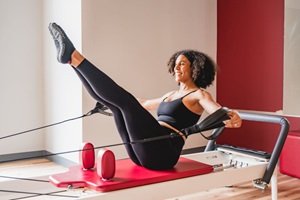 Exercises of all types are great for the body, helping participants burn calories, strengthen muscles, and maintain good health. Reformer Pilates classes, in particular, can be a revelation for beginners and enthusiasts, especially in core strength.
Exercises of all types are great for the body, helping participants burn calories, strengthen muscles, and maintain good health. Reformer Pilates classes, in particular, can be a revelation for beginners and enthusiasts, especially in core strength.
Supporting the core is one of the most essential endeavors any person can pursue because the body’s core is its source of stability. Reformer Pilates targets this area in a way that few other exercises can.
Despite the power of the reformer, beginners are often hesitant to sign up for class because they don’t know how to use one. The good news is that a great teacher will help all participants thoroughly learn how to use the reformer, which springs to switch to, and how to stay safe with proper form throughout the process.
So embrace the reformer and learn how much of a difference it can make for your core!
Why Core Strength Matters
Pilates touts its benefit for the core muscles; why does this matter so much? The core serves numerous essential functions for the body:
Posture
A person’s posture is determined, at least in part, by the orientation of their spine. When the core muscles are weak, they cannot exert sufficient pressure on the spinal column and surrounding muscles to pull the vertebrae into proper alignment.
With strong core muscles, people are likely to have a stable, aligned spine that is posturally correct and does not strain nearby muscles.
Stability
Speaking of stability, the core muscles can significantly affect how likely a person is to be injured. Core stability refers to the muscles’ ability to support the body as it moves. Suppose the core is unstable due to muscles that are not strong enough.
In that case, those muscles may improperly overextend when moving or fail to protect nearby structures from movement forces, leading to injury.
Movement
 Most people are not aware that their core impacts multiple types of movement, including the arms and legs, not just turning from side to side.
Most people are not aware that their core impacts multiple types of movement, including the arms and legs, not just turning from side to side.
Everyday movements, such as standing up out of a chair or reaching into a cupboard for a coffee mug, are safer and easier when the core is strong enough to support the skeleton while other muscles move.
The Muscles of the Core
The core is made up of a wide range of muscles, each with its role in addition to the job of working together for stability. Some of the most common muscles a person may work during Reformer Pilates are:
- The pelvic floor – The muscles near the bottom of the trunk that support the bladder and intestines.
- The transverse abdominis – A muscle that connects the core to the spine. Those with weakness in this muscle might feel pain in the lower back.
- The erector spinae – A large muscle that assists with rotating and straightening the back.
- The abdominal obliques – The two muscles running up the sides of the core, allowing a person to turn. Without strong enough obliques, a person may strain their torso.
- The rectus abdominis – The muscles associated with a “six pack”. They keep the core stable and help with daily movements.
Reformer Exercises That Target the Core
All Pilates exercises generally involve activating the core because Pilates is a full-body exercise, and most movements require at least some help from the core muscles. Many common exercises target the core either directly or indirectly:
- Planks, which require full core support and stability to maintain a straight spine
- Teasers, at a high level, use the core to hold the legs very high off the ground without allowing them to drop back down
- Seated reverse abs, which draw the torso away from the legs repeatedly using the movement action of the core
- Side box abs, which require heavy use of the obliques to pull the torso up and down while facing sideways
 These are just a few of the many exercises that Pilates participants can enjoy while strengthening the core. One of the reasons why Pilates is so revolutionary for core strength is that the reformer is highly adjustable.
These are just a few of the many exercises that Pilates participants can enjoy while strengthening the core. One of the reasons why Pilates is so revolutionary for core strength is that the reformer is highly adjustable.
If someone needs assistance with an exercise (or if they want a greater challenge), the reformer’s springs need only be adjusted so that everyone can get what their core needs from the same reformer.
Try Reformer Pilates for Yourself at RTR
Large biceps and traps might make you look powerful, but working the core is the secret to strong, supported movement that reduces the risk of injury. Without good core strength, the rest of the body, including the back and hips, will suffer over time.
The instructors at RTR Pilates can make core exercises accessible to everyone through the adaptable use of the reformer machine. Contact RTR Pilates today to sign up for a beginner class and see how it works!



